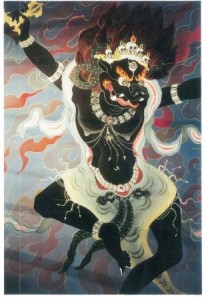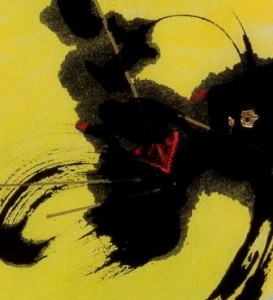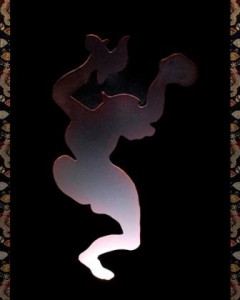Monday
Arts and PoetryLhadrima: Part Four of a Painter’s Journey
A Western Woman’s Journey as Painter of the Lha: The Noble Conquerors.
Click here for PART THREE in the Lhadrima series.
By Cynthia Moku
Looking back once again to 1974 when I watched Glen Eddy demonstrate the technique of brush-line drawing, I saw that within this strict use of a very fine sable brush dipped in black ink, a different kind of freedom was being engaged. This insight was not something I had experienced in all the freewheeling, self-expressive, late sixties painting classes at the Institute, nor in the graphic training I had received at the Academy. Glen did not say anything about relaxed discipline and I certainly didn’t come up with those words at the time. That phrase was not in my vocabulary yet. Still, the direct experience of witnessing calm vibrant presence in the execution of an elegant brushstroke made a definitive impression in my mind. There was something familiar and fundamental to an artist’s life in these experiences. That haunting recognition compelled me to learn more about this art form, which up to that time had not impressed me.
During the 1960s, my early years with the teachers at the Academy and the Institute unquestionably influenced my training and laid an unforeseen foundation towards the later development in Asian Buddhist art forms. One of my painting teachers encouraged me to express my powerful woman-ness throughout the painting process. I had no idea what he was talking about, but my rather classic anatomical figure drawings began moving into abstract dark charcoal forms that took on similarities to vast landscapes in a fluid world. Another teacher of figure drawing directed me to draw incessantly and quickly from live model poses. With few pauses in the continuum of eye-hand gesture, sixty-second drawings, thirty-second, ten-second…became impressions of dynamic flux.
Soon after school, hatha yoga of the Iyengar method, and Anapana and Vipashyana meditation of the Burmese tradition, were introduced to me. I quickly signed up for a strict two-week retreat, and quite a few more retreats followed in the next few years. I practiced Iyengar yoga and became a teacher of it for some years under the direction of my yoga and breath awareness meditation teacher. These adventures led me to the point when Kalu Rinpoche arrived in 1973 and stayed at the home I was sharing with fellow dharma brother and artist, Sanje Elliott, and others in Marin County California.
An artist’s life work is not solely a one-woman show. It can be looked at that way–in the sense of execution, expression and productivity. However, at least speaking for myself, my work derives from all my connections, all the people who have been and currently are a part of my life. It results from very intimate close relations such as I have with my four children, now adults and artists in their own right, and my parents who gave me oil paints at age six, to the full web of sentient beings that inhabit this earth, which also holds my small studio where I spend hours, mostly alone, a very tiny dot on the globe. Many others that I have not mentioned in this writing have influenced my work. I know who they are–those whom without their passage into my life, the art I have done would not be as it is. Thank you to all those relations.The blessing of Kalu Rinpoche’s command set me on this lifetime path, and in whatever way the work that I have done contributes to the welfare of beings and the integrity of the lineage of painters, it is because of his wisdom and generous guidance in pointing out the way to such a novice. And with the auspicious fortune of being soaked in the environment of the Vidyadhara Chogyam Trungpa Rinpoche’s creative genius, the discipline of thangka painting became a wide introduction to what I have referred to in many public lectures as “discovering the disguised messenger of creative freedom.” The messenger is the field of blessings the realized teachers continue to bestow on all of us. The disguise is simply the direct magic of their profound capacities, their stainless love never subject to change or decay.
To paint a picture summarizing my journey, it is as though Kyabje Kalu Rinpoche has held the doors wide open for me to step inside this world of painting the traditional iconography of the Awakened Ones. Then the Vidyadhara Chogyam Trungpa Rinpoche came along and suggested that while inside, I can dance.
Now, at sixty-one years of age, my hand is still steady, my eyesight varies, while the ability to focus right where I choose and the dexterity of full-bodied gestures keeps me painting and drawing. Unfortunately, the economic situation has left me without a jindak, a financial patron. This loss is something I have been working hard to overcome the last two years, resulting in an increase in my studio and teaching activity. Still, resources are stretched dangerously thin. There are projects in the works that I dearly hope to complete, but with the elegant passage of time comes a gnawing realization that soon I may have to put down my brushes.
“Life is short; art is long”—a statement attributed to Hippocrates, the Greek physician/philosopher of the fifth century BCE. He was referring to the wealth of information and wisdom one must train in to perfect the “art of healing.” This statement applies equally to thangka painting as a visual art technique and as a practice of enduring liberation. Such development is generational and will continue, appropriately manifesting in skillful fashion through time and place for the benefit of all beings.This innovative generational lineage-link is most prominently being reflected in the work I do now for the Kongma Sakyong, His Majesty Jamgon Mipham Rinpoche. It is my wish that the works I do for Rinpoche will help in extending his clear guidance for our present-day circumstance–teachings that are marked with a forward-moving discernment while staying anchored within the compassion and wisdom of the Noble Conquerors.
In his elegant and refined manner, a hallmark of his awakened activity, Kalu Rinpoche once instructed me, “If an ant should walk across your painting even while you are working on it, let the ant go by in its own time. That insect is making a connection with the buddhas.”
_____________________________
Cynthia Moku was appointed Artist to the Kalapa Court in 2008.




















May 12, 2011
Reply
Hi Cynthia. Wonderful! Sounds like an elephant!